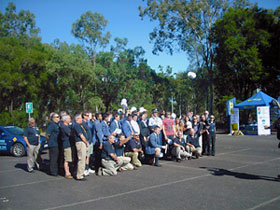
197 learner drivers throughout the nation participated in simultaneous driving lessons this morning, setting an unofficial world record for the largest driving lesson ever staged as well as raising awareness about road safety.
The learner drivers and their instructors participated in simultaneous driving lessons at 10 locations across Australia including Adelaide, Brisbane (two venues), Canberra, Darwin, Gold Coast, Hobart, Mackay, Newcastle and Townsville.
The WLDL, a signature event of the Fatality Free Friday Road Safety Foundation, launches a month of activities centred on road safety and reducing Australia’s road fatalities.
“To be verified as an official Guinness World Record, we needed 250 learner drivers and their instructors to participate in the driving lessons. Unfortunately, we didn’t quite hit our target this year. However, this is still the largest number of learner drivers to ever participate in simultaneous driving lessons, setting an unofficial world record – and that’s a great achievement,” said Russell White, Founder and Chairman of the Fatality Free Friday Road Safety Foundation.
“Importantly, today’s event was designed to increase awareness about the importance of ongoing driver education and training as well as encourage young drivers to think consciously about driving safely every time they get behind a wheel. The Fatality Free Friday Road Safety Foundation is committed to improving road safety and reducing driver trauma and fatalities on Australian roads through initiatives such as the driving lesson.
“We congratulate all the learner drivers who participated throughout the country and wish them well on their journey to obtaining their drivers’ licences,” said Russell.
In 2010, 153 learner drivers participated in the inaugural World’s Largest Driving Lesson record attempt.
WLDL’S TOP TIPS FOR LEARNER DRIVERS
1. Commit to studying the art of driving
Practice, practise, practise. Remember no matter how good a driver you think you are, there is always room to improve your driving skills and knowledge.
2. Be the master of your own destiny
Do not be influenced by other passengers or motorists and do not be intimidated into doing something illegal or unsafe. When you are behind the wheel you are responsible.
3. Look as far ahead down the road as you can
Looking ahead will help you plan your moves more effectively. It will also improve how you read road conditions and work with the traffic flow.
4. Keep a safe following distance and don’t travel too close to the vehicle in front
Many drivers underestimate the time and distance it will take to stop the vehicle in a crisis. When travelling behind another vehicle allow yourself at least a three second gap. Increase this distance if the driving conditions deteriorate.
5. Adjust your driving to suit the conditions
You should not be driving beyond what you can see and the effective grip of your tyres is paramount. The golden rule is, if conditions are deteriorating – SLOW DOWN.
6. Be as smooth as you can with the vehicle’s controls
Good driving is all about being smooth and progressive with the vehicle’s controls. Abusing the car, harsh and violent steering, and aggressive braking can contribute to loss of control.
7. Driver fitness
Ask yourself “am I in a fit condition to drive?” DO NOT drive if you are tired or under the influence of alcohol or drugs.
8. Stay focused
When you’re behind the wheel you need to focus on just one job, driving the car. Everything else is a distraction that could have catastrophic consequences.
9. Stick to the road rules
Not obeying the road rules is a major contributing factor in many road crashes. The road laws are there for the safety of everyone on the road.
10. Buckle up
Seat beats save lives. Making sure you and everyone in your car are wearing a seat belt is arguably the most significant thing you can do to improve your level of safety whilst driving.
11. Maintain the vehicle in a roadworthy condition
A car is like any other piece of machinery – it needs regular maintenance to keep it working properly. Be familiar with the basics such as checking tyre pressure, engine oil, and coolant as well as brake and power steering fluid.
